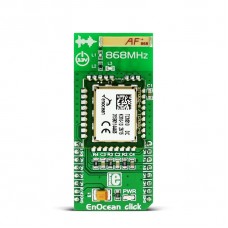EnOcean click
Description
EnOcean click carries a TCM 310 transceiver, which is a bidirectional gateway for EnOcean’s 868 MHz radio systems. The click is designed to run on a 3.3V power supply. It communicates with the target MCU through UART (TX, RX pins), with additional functionality provided by RST and EN pins.
Note: Modules with 868 MHz frequency are suitable for Europe and other countries adopting R&TTE specification. Versions of EnOcean click covering different frequency bands will be available in the future.
TCM 310 transceiver
This low-powered wireless module is intended for use together with EnOcean’s range of energy harvesting modules that include self-powered, battery-free wireless switches, sensors and actuators.
Essential features
EnOcean offers a range of modules compatible with TCM 310. Those are miniaturized energy converters that use the surrounding environment — motion, light or temperature differences — to harness enough energy to send a wireless signal to the receiver onboard EnOcean click.
The TCM 310 module can also be set up as a repeater to extend the range of the signal. You can then develop various battery-free switching systems, data loggers and similar.
Onboard antenna
EnOcean click features a small high-performance 868MHz chip antenna onboard so no external antennas are required.
Key features
- TCM 310 transceiver
- Frequency: 868 MHz EnOcean
- Data rate: 125 kbps
- Onboard antenna
- Interface: UART
- 3.3V power supply
Specification
| Type | RF Sub 1GHz |
| Applications | Incorporate battery-free wireless energy harvesting modules into your designs |
| On-board modules | TCM310 transceiver |
| Key Features | Bidirectional gateway for EnOcean 868 MHz radio systems. Compatible with EnOcean energy harvesting modules |
| Key Benefits | Communicates with battery-free switches, sensors and actuators. Onboard chip antenna |
| Interface | GPIO,UART |
| Input Voltage | 3.3V |
| Compatibility | mikroBUS |
| Click board size | L (57.15 x 25.4 mm) |
Pinout diagram
This table shows how the pinout on EnOcean click corresponds to the pinout on the mikroBUS™ socket (the latter shown in the two middle columns).
Programming
The function sends ESP3 packet header and data over UART interface to an EnOcean module.
01 uint8_t sendMessage(ESP3Pack* esp){
02
03 uint8_t i=0;
04
05 if((esp->header.dataLength || esp->header.oppDataLength) == 0)
06 {
07 return -1;
08 }
09
10 UART2_Write(esp->syncByte);
11 UART2_Write((esp->header.dataLength & 0xFF00)>>8);
12 UART2_Write((esp->header.dataLength & 0xFF));
13 UART2_Write(esp->header.oppDataLength);
14 UART2_Write(esp->header.packetType);
15 UART2_Write(esp->headerCRC);
16
17 for(i=0; i < esp->header.dataLength; i++)
18 UART2_Write(esp->dataESP3[i]);
19 for(i=0; i < esp->header.oppDataLength; i++)
20 UART2_Write(esp->optData[i]);
21
22 UART2_Write(esp->dataCRC);
23
24 return 0;
25 }
Downloads
mikroBUS™ Standard specification
LibStock: EnOcean click library
Enter the code in the box below:










